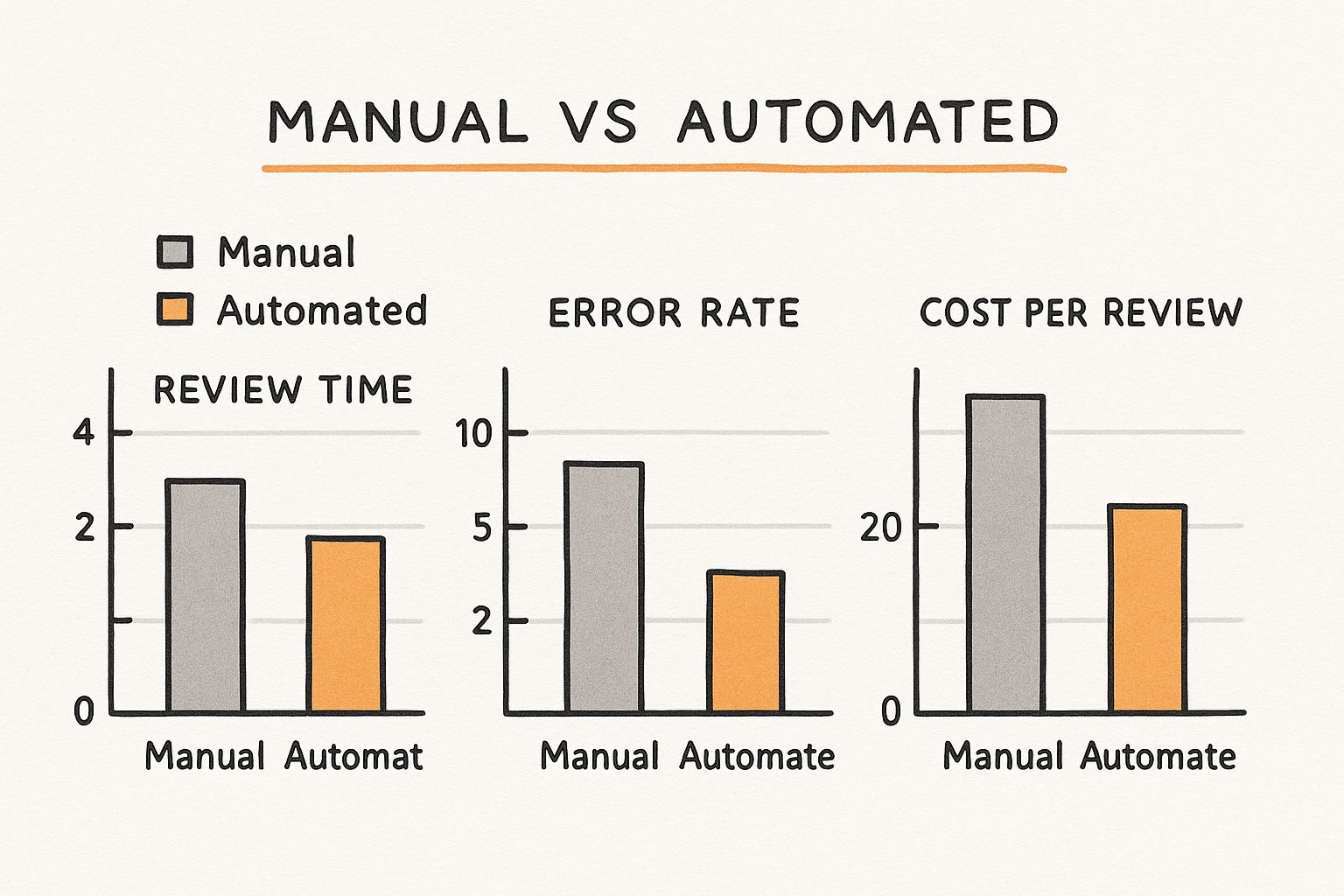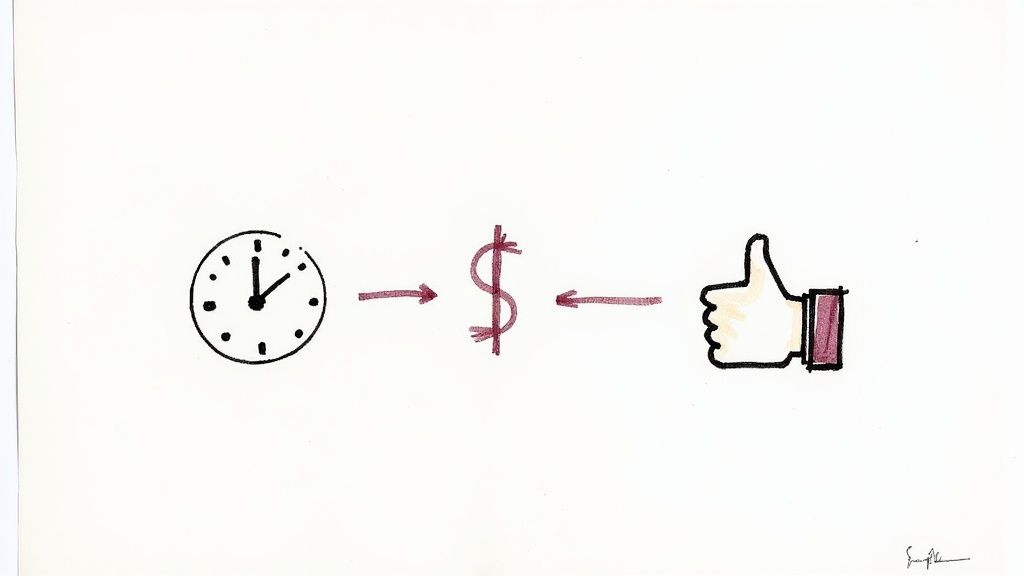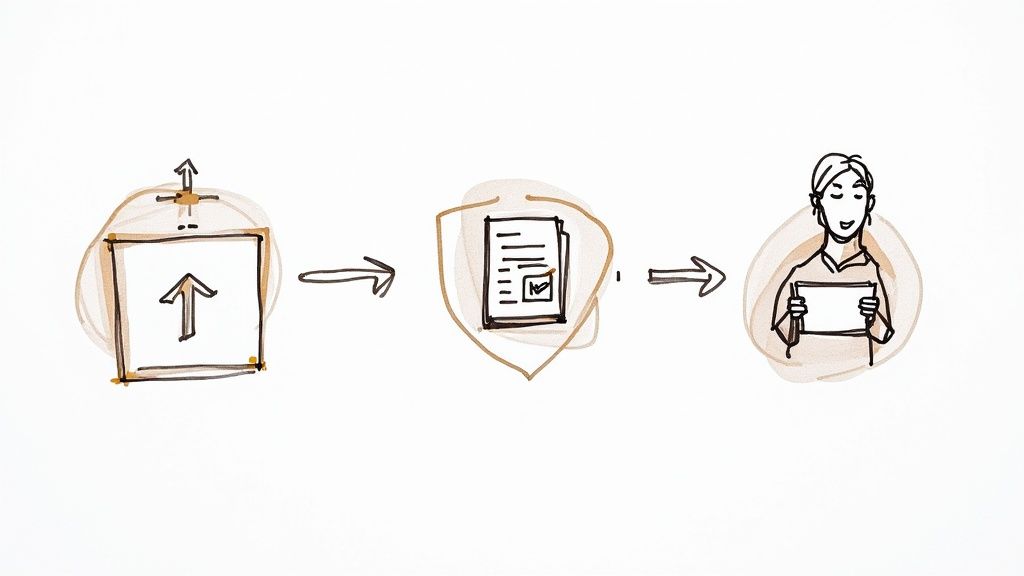Ever been handed a long contract and felt your eyes glaze over? You're not alone. Legal document review software is a type of tool that uses artificial intelligence (AI) to do the hard work of reading, understanding, and organizing complicated legal documents for you. In simple terms, it helps you find the important stuff, spot potential problems, and actually understand what you’re signing—without having to spend hours drowning in confusing legal text.
Why Reading Documents the Old-Fashioned Way Is So Hard
Have you ever tried to read a 30-page rental agreement or a freelance contract filled with baffling legal terms? Maybe you just needed to find that one little sentence about late fees. For most of us, it feels like searching for a needle in a haystack. It’s boring, stressful, and takes forever. You read the same paragraphs over and over, and you still walk away worried you might have missed something important.
Doing it this way isn't just frustrating; it’s easy to make mistakes. A single missed detail or one misunderstood term can lead to serious money or legal trouble down the road. This isn't just a problem for lawyers. It’s a huge headache for small business owners, freelancers, and pretty much anyone who has to sign a complex agreement.
A Smarter Way to Review Documents
Now, imagine having a team of super-fast digital assistants. Instead of you slowly reading through every single line, legal document review software scans the whole thing in minutes. It instantly highlights key sections, explains confusing terms, and flags potential red flags that need your attention.
This technology is like your own personal guide, breaking down intimidating walls of text into simple, easy-to-understand points. It gives you the power to grasp the main promises and risks at a glance, no law degree required. The whole point is to level the playing field, giving you the confidence that comes from knowing exactly what you're agreeing to.
The real benefit here is turning a long, stressful task into a quick, simple process. It’s about saving time, cutting down on stress, and finally getting some clarity.
A quick look at the numbers shows just how different the two approaches are. The chart below breaks down the huge differences in time, error rate, and cost when you compare reading a document yourself versus using software.
Manual Review vs Software Review At a Glance
| Aspect | Manual Document Review | Software Assisted Review |
|---|---|---|
| Time | Hours or days per document | Minutes per document |
| Accuracy | High potential for human error | Significantly lower error rates |
| Cost | High (billable hours or opportunity cost) | Low, predictable subscription fees |
| Focus | Tedious line-by-line reading | Strategic review of key insights |

As you can see, using software can easily cut your review time in half while drastically reducing errors and costs. For anyone who deals with contracts or agreements regularly, that kind of efficiency is a total game-changer.
How This Software Actually Works

So, how does a piece of software manage to turn a dense wall of legal language into something you can actually use? It’s not magic, but it’s close. At its heart, legal document review software uses artificial intelligence (AI) to read and understand documents much like a person would, only thousands of times faster and without getting tired.
Think of it as giving the software a set of super-smart digital highlighters. As it scans your document—whether it’s a new apartment lease or a freelance contract—it’s trained to recognize and color-code different bits of information. One color might be for dates and deadlines, another for names and responsibilities, and a third, more important color for potential risks or unusual rules.
This goes way beyond a simple keyword search. Instead of just finding the word "payment," the AI understands what’s happening around it. It figures out the amount, the due date, and any penalties for being late. This smart approach is why the legal tech field is booming. The market was valued at $2.49 billion in 2024 and is expected to hit $9.67 billion by 2034. It’s a clear sign of just how essential these tools are becoming. You can dig into the full legal document management software market analysis to see just how fast this is all moving.
A Breakdown of the Key Features
To make this less technical, let’s look at the key features that do all the heavy lifting. These tools work together to give you a clear, useful summary of any complex legal document you feed it.
- Finding Key Sections: The software automatically finds and labels specific parts—like rules for ending the contract, confidentiality agreements, or sections on who’s responsible for what—so you can jump right to the parts that matter most to you.
- Pulling Out Details: It pulls out important details like the names of people and companies, important dates, locations, and dollar amounts. This creates a quick summary of the who, what, when, and where.
- Spotting Risks: This is where the real power is. The AI is trained to spot language that could be risky or unfair. It flags unusual terms or sneaky rules that might put you in a bad spot later on.
A Real-World Example
Let's say you're a freelance graphic designer and you just got a new client contract. It's 15 pages long and packed with jargon. Instead of spending half your day trying to figure it out, you upload it to the review software.
Within seconds, you get a summary. It points out that the payment term is "Net 60," meaning you'll have to wait two months to get paid—a lot longer than your usual "Net 30." It also flags a section that gives the client ownership of all your draft designs, not just the final one.
This instant analysis is the software's true value. It doesn’t just show you what’s in the contract; it helps you understand what it means for you, turning confusing legal talk into simple, helpful advice.
On top of that, the software can also perform redaction, which is a fancy term for securely blacking out sensitive information. If you need to share the contract with a partner but want to hide your personal bank details, the software can remove that data for good, keeping your privacy safe.
Real-World Benefits for Everyday Users

All the technical talk is great, but what does it actually do for you? The real magic of legal document review software is how it takes a complicated, often stressful task and makes it simple. It’s all about turning those fancy features into real benefits that make your life easier.
Think about it. AI-powered analysis isn’t just a cool feature; it’s about getting your weekend back. Instead of losing five hours carefully reading a dense contract, the software can pull out the most important points in five minutes. This huge time-saving is often the first thing people notice and love.
And having it online? That’s not just about storage. It’s the freedom to pull up an important rental agreement on your phone while you’re standing in the apartment, or to double-check a freelance contract from a coffee shop. Your most important documents are always secure, easy to find, and ready when you are.
Saving Money and Reducing Risk
Let's be honest: one of the biggest problems with legal documents is the cost. Hiring a lawyer to look over every single contract just isn't an option for most small businesses or individuals. This is where document review software acts as your first line of defense, dramatically cutting down on those potential expenses.
While it’s not a replacement for a real lawyer, the software does the initial hard work. It flags confusing language and risky sections, giving you the power to either negotiate better terms on your own or go to a lawyer with specific, targeted questions. This makes any legal help you do need much more efficient and affordable.
Think of it as a smoke detector for your contracts. It alerts you to potential dangers before they turn into big problems, giving you the chance to act early and protect yourself from costly mistakes.
A Small Business Success Story
Take the real-world example of a small bakery owner who got a new contract from a major food supplier. The document was pages and pages of dense legal text, but before signing, she ran it through TermsEx.
In minutes, the software flagged a sentence buried deep on page 17. This single sentence gave the supplier the right to increase prices by up to 30% with only one week's notice.
Spotting that one clause probably saved her business thousands in surprise costs down the line. She was able to go back and negotiate for a fixed price, protecting her profits and preventing a future cash flow disaster. It's a perfect example of how the software’s accuracy catches critical details that tired human eyes might easily miss.
Of course, protecting yourself also means knowing how your own data is handled. You can learn more about our commitment to your privacy by reviewing our TermsEx privacy policy.
Choosing the Right Software for Your Needs

With more and more document review tools out there, picking the right one can feel confusing. The secret is to ignore the marketing hype and focus on what you actually need. A feature-packed tool built for a giant law firm is almost certainly too much for checking your new apartment lease.
To cut through the noise, just ask yourself a few key questions. Your answers will quickly help you find a tool that makes your life easier, not more complicated.
What Documents Will You Review?
First things first: what kind of documents are you dealing with? There’s a big difference between a standard rental agreement and a high-stakes business contract.
- Simple Documents: If you’re looking at rental agreements, privacy policies, or basic freelance contracts, you’ll want a user-friendly tool that gives you clear summaries and flags potential risks. You don't need a tool loaded with a dozen features you’ll never touch.
- Complex Contracts: For business owners looking at vendor agreements, partnership deals, or investment documents, you’ll need more power. Look for a tool with stronger analysis that can track specific promises and rules across multiple files.
This is where a specialized tool really shines. A platform like TermsEx, for instance, is built specifically for consumers and small businesses, helping you understand everyday documents in minutes without getting bogged down in legal complexity.
How Easy Is It to Use?
Let’s be real—the whole point of this software is to save time and stress. A clunky, confusing program completely defeats the purpose.
Look for a clean, simple design. You should be able to upload a document and get your summary with just a few clicks. Most modern tools offer free trials or demos, and you should definitely take advantage of them. A quick test run is the best way to see if a tool feels right for you.
The best tools are all about simplicity, making sure you can get a document analyzed in seconds without needing to read a manual. That kind of user-friendly approach is what makes these tools so valuable for people who aren’t lawyers.
What Is the Pricing Model?
Cost is always a factor. Pricing for legal document review software can range from a few dollars to thousands, so it’s important to find a plan that fits your budget and how often you’ll actually use it.
- Monthly Subscription: This is often a great fit for small business owners or freelancers who review a few contracts every month.
- Pay-Per-Document: An excellent choice if you only need to review a document once in a while, like when you get a new lease or a job offer.
How Secure Is Your Data?
This last one is a deal-breaker. You have to be 100% confident that your sensitive information is safe.
Before you even think about uploading a document, look for clear statements about data security and privacy. A trustworthy company will use strong encryption to protect your files both when you upload them and while they’re stored.
Always take a moment to review the company's data policies. For example, understanding a platform's commitment to security—like the details you can find in our Terms of Service—is a critical step before trusting it with any confidential information.
What's Next for Legal Tech? A Look Ahead
The world of legal technology is moving incredibly fast. What felt like science fiction just a few years ago is now becoming normal. While the software we use today is already powerful, the next big thing is all about making legal document tools smarter and more helpful. We're moving away from tools that just react to a document toward tools that can guess what you'll need next.
Imagine a system that doesn’t just flag a weird rule in a contract. Instead, it predicts potential legal problems down the road by spotting patterns it has learned from looking at thousands of similar agreements. That's the idea behind predictive analysis. Instead of waiting for a problem to pop up, this next-generation software helps you avoid it entirely, offering a level of foresight that used to be impossible.
Advanced Tech is No Longer Just for the Big Guys
For a long time, this kind of advanced technology was locked away, available only to huge companies with equally huge budgets. The future, however, is about making it available to everyone. Modern platforms are making these powerful tools more affordable and much easier to use, finally putting them in the hands of individuals, freelancers, and small businesses.
This opening up of legal tech is leading to serious growth. The market for legal document drafting software, a close cousin to review software, is a great example. It's projected to hit around $2.5 billion in 2025. From there, it’s expected to balloon to an estimated $7.8 billion by 2033, which shows a huge demand for automated legal solutions. You can dig into the numbers by exploring the latest legal software market projections.
The big takeaway is that managing your legal life is becoming a much more straightforward, automated process. This shift gives everyone the power to handle legal complexities with more confidence and a lot less anxiety.
The best part? This future isn't years away—it's already here. Using legal document review software today is more than just a convenience; it's a smart investment in your own efficiency and peace of mind. It’s about taking control of your agreements and making sure you’re always protected.
Frequently Asked Questions
When you're looking into new technology like legal document review software, you're bound to have some questions. Here are simple answers to the ones we hear most often.
Can This Software Replace a Lawyer?
No, this software is a powerful assistant, not a substitute for a real lawyer. Think of it as a super-smart helper that can instantly spot potential red flags, summarize dense sections, and organize key information for you.
For actual legal advice, high-stakes negotiations, or creating a contract from scratch, you absolutely need to talk to a human attorney. The software’s real value is in making your time with them more efficient—you'll show up better informed, which saves both time and money.
Is My Confidential Information Safe?
Security is everything in legal tech, and any good company will make it their top priority. They use advanced encryption and follow strict data privacy rules to keep your documents locked down.
Before signing up for any platform, always take a look at their security policies. You'll want to see things like secure access, proof they meet industry standards, and features that let you black out sensitive information.
How Much Does This Software Cost?
The price can vary quite a bit. Huge platforms built for massive law firms can carry a hefty price tag. However, many of the newer tools designed for small businesses and individuals are much more affordable.
You’ll often find budget-friendly monthly subscriptions or even pay-per-document options. In almost every case, the cost is just a tiny fraction of what you’d spend for a lawyer to review it, so the savings add up quickly.
If you have more specific questions about how this all works or which solution might be the best fit for you, feel free to reach out to our team. We're happy to help.
Ready to decode your documents with confidence? Try TermsEx today and transform confusing legal jargon into clear, actionable insights in minutes. Get started for free at https://termsex.com.
Article created using Outrank